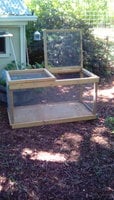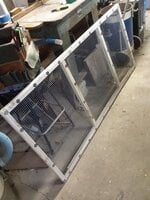I'm finally getting ready to get my brooder set up with a wire floor. What I need to do is build a frame (or two, depending on how wide the opening is vs. where the floor will sit) and stretch hardware cloth over it. That part I'm fine with, gonna get some 1.5" square furring strips and screw together, easy peasy. The part I'm chewing on is how I'm going to attach the hardware cloth.
Obviously, the tighter I can stretch it, the better. I'm going to use regular staples just to hold it down on the outside edges that will butt against the brooder interior. But for attaching it on top, am I better off using screws with washers, or poultry staples? I'm kind of leaning towards the poultry staples since I already have a box and the screws and washers seem like they'd be a little harder to get placed well for maximum tightness. I'll either be using C-clamps to hold the second side in place or calling a friend to hold it tight.
Figured it can't hurt to ask if there's a best way or something I haven't considered. @aart ?
FYI - I understand not everyone approves of raising chicks on wire. That's fine, but I've made the choice and am doing it regardless. Keeping them away from their waste and keeping shavings out of the food and water is important to me.
Obviously, the tighter I can stretch it, the better. I'm going to use regular staples just to hold it down on the outside edges that will butt against the brooder interior. But for attaching it on top, am I better off using screws with washers, or poultry staples? I'm kind of leaning towards the poultry staples since I already have a box and the screws and washers seem like they'd be a little harder to get placed well for maximum tightness. I'll either be using C-clamps to hold the second side in place or calling a friend to hold it tight.
Figured it can't hurt to ask if there's a best way or something I haven't considered. @aart ?
FYI - I understand not everyone approves of raising chicks on wire. That's fine, but I've made the choice and am doing it regardless. Keeping them away from their waste and keeping shavings out of the food and water is important to me.






 Turned out alright, though I wish it was tighter. It should work though.
Turned out alright, though I wish it was tighter. It should work though.
